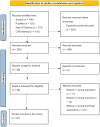Public perception of new plant breeding techniques and the psychosocial determinants of acceptance: A systematic review
- PMID: 38863424
- PMCID: PMC11290029
- DOI: 10.1177/09636625241254981
Public perception of new plant breeding techniques and the psychosocial determinants of acceptance: A systematic review
Abstract
Advancements in New Plant Breeding Techniques have emerged as promising tools for enhancing crop productivity, quality, and resilience in the face of global challenges, such as climate change and food security. However, the successful implementation of these techniques relies also on public acceptance of this innovation. Understanding what shapes public perception and acceptance of New Plant Breeding Techniques is crucial for effective science communication, policymaking, and the sustainable adoption of these innovations. The objective of this systematic review was to synthesize existing research on the public perception of New Plant Breeding Techniques applied to food crops and explore the psychosocial determinants that influence acceptance. Twenty papers published between 2015 and 2023 were included on various New Plant Breeding Techniques and their reception by the general public. Determinants affecting the acceptance of food crops derived from New Plant Breeding Techniques were categorized into six areas: sociodemographic factors, perceived benefits and risks, attitudes toward science, communication strategies, personal values, and product characteristics.
Keywords: consumer psychology; food crops; genome editing; new plant breeding techniques; psychosocial determinants; public acceptance; public perceptions.
Conflict of interest statement
Declaration of conflicting interestsThe author(s) declare no potential conflicts of interest with respect to the research, authorship, and/or publication of this article.
Figures
Similar articles
-
Health professionals' experience of teamwork education in acute hospital settings: a systematic review of qualitative literature.JBI Database System Rev Implement Rep. 2016 Apr;14(4):96-137. doi: 10.11124/JBISRIR-2016-1843. JBI Database System Rev Implement Rep. 2016. PMID: 27532314
-
The Lived Experience of Autistic Adults in Employment: A Systematic Search and Synthesis.Autism Adulthood. 2024 Dec 2;6(4):495-509. doi: 10.1089/aut.2022.0114. eCollection 2024 Dec. Autism Adulthood. 2024. PMID: 40018061 Review.
-
Factors that influence parents' and informal caregivers' views and practices regarding routine childhood vaccination: a qualitative evidence synthesis.Cochrane Database Syst Rev. 2021 Oct 27;10(10):CD013265. doi: 10.1002/14651858.CD013265.pub2. Cochrane Database Syst Rev. 2021. PMID: 34706066 Free PMC article.
-
Evolution of agricultural biotechnology is the paradigm shift in crop resilience and development: a review.Front Plant Sci. 2025 Jun 19;16:1585826. doi: 10.3389/fpls.2025.1585826. eCollection 2025. Front Plant Sci. 2025. PMID: 40612601 Free PMC article. Review.
-
Women's experience of menopause: a systematic review of qualitative evidence.JBI Database System Rev Implement Rep. 2015 Sep 16;13(8):250-337. doi: 10.11124/jbisrir-2015-1948. JBI Database System Rev Implement Rep. 2015. PMID: 26455946
References
-
- Baum CM, Kamrath C, Bröring S, de Steur S. (2023) Show me the benefits! Determinants of behavioral intentions towards CRISPR in the United States. Food Quality and Preference 107: 104842.
-
- Bearth A, Kaptan G, Kessler SH. (2022) Genome-edited versus genetically-modified tomatoes: An experiment on people’s perceptions and acceptance of food biotechnology in the UK and Switzerland. Agriculture and Human Values 39(3): 1117–1131.
-
- Braun V, Clarke V. (2006) Using thematic analysis in psychology. Qualitative Research in Psychology 3(2): 77–101.
Publication types
MeSH terms
LinkOut - more resources
Full Text Sources




